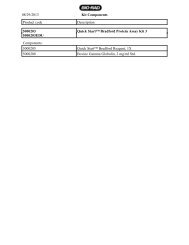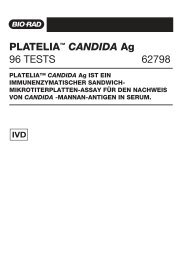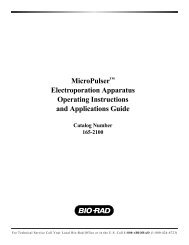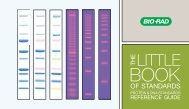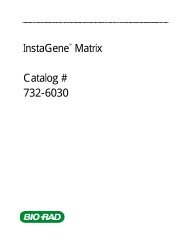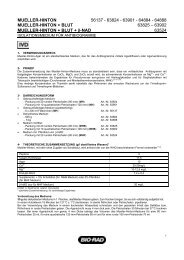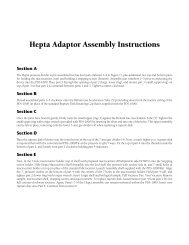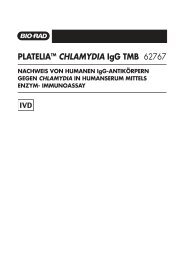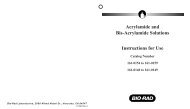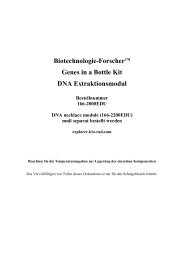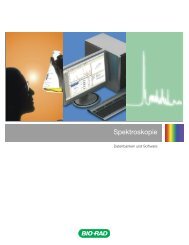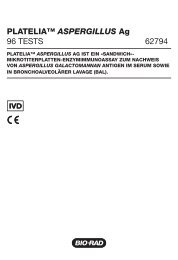Protein Expression and Purification Series - Bio-Rad
Protein Expression and Purification Series - Bio-Rad
Protein Expression and Purification Series - Bio-Rad
Create successful ePaper yourself
Turn your PDF publications into a flip-book with our unique Google optimized e-Paper software.
<strong>Protein</strong> <strong>Expression</strong> <strong>and</strong> <strong>Purification</strong> <strong>Series</strong><br />
<strong>Bio</strong>Logic LP System <strong>and</strong> <strong>Bio</strong>Logic Duoflow System<br />
<strong>Purification</strong> Results Analysis<br />
The gel image below in Figure 4 shows how typical results using the Chromatography Instrumentation<br />
<strong>Purification</strong> Process should appear. Listed below are common steps that can help you analyze your results.<br />
1 2 3 4 5 Figure 4. Lane 1, molecular weight<br />
markers; lane 2, uninduced sample; lane<br />
250 kD<br />
3, induced sample; lane 4, insoluble<br />
fraction; lane 5, soluble fraction.<br />
150<br />
100<br />
75<br />
50<br />
37<br />
25<br />
20<br />
15<br />
10<br />
Step 1: Check that induction occurred.<br />
The GST-DHFR-His protein runs on SDS-PAGE gels at an apparent MW of approximately 43 kD. (Note that<br />
the protein runs at this weight despite the actual protein MW of approximately 52 kD.)<br />
Results: An obvious b<strong>and</strong> should appear in lane 3 that is not present in lane 2 between the 37kD <strong>and</strong><br />
52 kD molecular weight markers if the GST-DHFR-His has been strongly induced.<br />
Step 2: Check that lysis worked.<br />
Lanes 4 <strong>and</strong> 5 represent the insoluble <strong>and</strong> soluble fractions, respectively.<br />
Results: If the GST-DHFR-His was strongly induced <strong>and</strong> the cells were lysed, a b<strong>and</strong> should be present<br />
in lane 5 that is approximately 43 kD. It should be the same size as the b<strong>and</strong> that occurred in lane 3 (falls<br />
between the 37kD <strong>and</strong> 50 kD molecular weight markers). Please note that the large b<strong>and</strong> that is apparent<br />
at approximately 12 kD in lanes 4 <strong>and</strong> 5 is the lysozyme used to lyse the cells <strong>and</strong> not GST-DHFR-His.<br />
GST-DHFR-His is expressed in both a soluble <strong>and</strong> insoluble form. It is likely that there will be strong b<strong>and</strong>s<br />
in both lanes 4 <strong>and</strong> 5 at around 43 kD, representing both insoluble <strong>and</strong> soluble GST-DHFR-His respectively.<br />
As long as there is a strong b<strong>and</strong> in lane 5, lysis has occurred, <strong>and</strong> soluble GST-DHFR-His has been<br />
released.<br />
Figure 5. <strong>Bio</strong>Logic LP Chromatogram showing a large peak of flowthrough (between 2–8 minutes in the chromatogram above)<br />
<strong>and</strong> the smaller peak of purified GST-DHFR-His eluate (between 14–16 minutes in the chromatogram above).<br />
Appendix B: <strong>Purification</strong> Results Analysis<br />
Induced GST-DHFR-His<br />
lysozyme<br />
Flowthrough Wash Eluate<br />
215<br />
APPENDIX B<br />
RESULTS ANALYSIS



